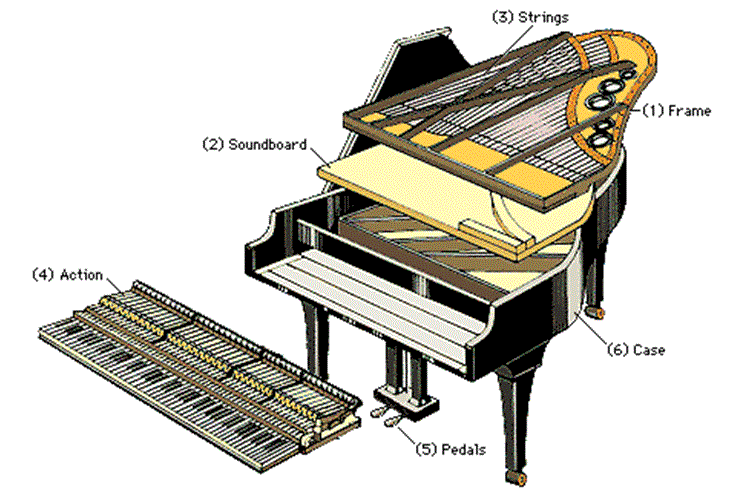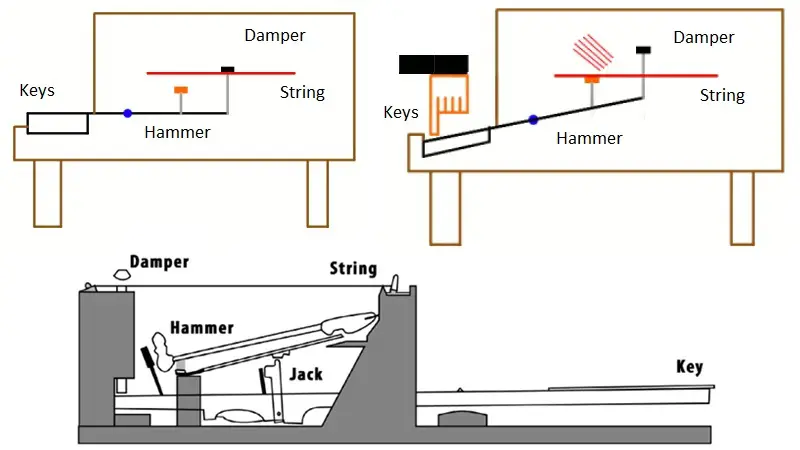
How Pianos work. If you’re a music student or a proud owner of piano, it’s good to know how the grand piano makes such a beautiful sound. Here we take a look inside a piano.
Piano is a percussion instrument
Lot of people will find it difficult to accept this fact, considering that fact that most piano keyboards are capable of playing so many tones, and the acoustic ones use strings to produce the sound.
But then, if you look at the mechanism of a piano it is actually a series of hammers that hit the strings. And so that makes it a percussion instrument, though some musicologists like to classify it as a “keyed zither”.
Why you need to know how it works?
Knowing how pianos work can come in handy if, in case, anything goes wrong with your piano. It will help you to determine what needs to be fixed. So go ahead, press a key and check how the various parts inside a piano move. Lift the lid and see how piano works.
It will also help you to examine a used Piano, in case you’re planning to buy one.
Here’s more on how acoustic pianos work.
How a Piano Produces Sound
- The piano is like a huge frame which is shaped like the (grand) piano. It has a soundboard, which is sort of the bottom of the piano. The soundboard is like the back of the cello or the back of the violin or bass, and provides resonance. Without a soundboard, the sound won’t go anywhere.
- A piano has close to 230 strings, and it’s these strings which produce the sound. When you push down a piano key, a hammer is pressed against one of those strings to produce a sound.
- The key of the piano works like a lever, it pushes a whole bunch of little pieces (that are connected to a little hammer) to produce the sound. When you press the key, all those things start to move, the roller rolls the hammer up, which strikes the string, and the damper gets lifted up. When you release the piano key, the sound stops (the hammers rest against dampers).
- Science students may probably already know about this – the length of the strings makes the pitch sound higher or lower. Shorter and thinner strings produce higher pitched notes (the ones on the right side of the keyboard). The longer and thicker strings producer heavy (bassy) tones, these are located on the left side of the keyboard.

Main Components / Parts of Piano
Three separate assemblies (consisting of several different parts) spring into action when a pianist’s finger hit the keys – the key assembly, the wippen assembly, and the hammer assembly. The wippen assembly transfers the key’s force to the hammer, “throwing” it towards the string.
When you press a piano key, a “damper” (or mute) is lifted off the string, allowing the string to resonate and produce sound. When the key is released, the damper again rests on the string thus muting the string. This way a note only sounds so long as the key is pressed.
Read: The various parts of a piano.
Generally speaking, any acoustic piano will have these main components / parts which work together to produce a sound.
More on the Piano Keys
While it is good to know about the various parts of a piano, piano students, teachers and performers would probably be the most interested in the piano keys. After all, the feel of the keys is an important buying factor.
Also, any problem with the piano key is a major irritant as it hampers with yur practice unless you fix it.
In the past, piano keys had a thin layer of ivory. Ivory helped get a nice grip on the keys but it yellowed, chipped over time (due to regular playing).
Ivory has been banned in several countries and so piano keys no longer use real ivory.
So what are piano keys made of now?
Most piano keys are made of wood (spruce). Its also common to use plastic tops on white keys and ebony for the black keys.
In case, you own a piano that was constructed before the 1940s that has yellowed, slightly porous keys, they are probably covered with ivory. The ivory on piano keys is so thin and ages so quickly that it is almost worthless as a raw material.
Digital Piano Keyboards Work Differently
A digital keyboard instrument runs on electricity; its more like a computer with several chips inside that not only stores the various sounds, but also processes whatever keys you press and displays it on the lcd display. So it’s more like a mini computer, but an inexpensive one.
Digital Means Samples! That’s correct; digital keyboard instruments use samples (sound recordings) of various acoustic pianos, and those samples are stored in a chip on the digital piano. The chip then produces the various sounds on the digital piano.
In a digital one, the sound producing mechanism is digitized. Recordings of the sounds in various situations such as when the keys are played harder or softer, is recorded and is used whenever required.
There is a sound bank that not only stores the sounds for each and every key and octave, it also stores how it should sound depending on what pressure / velocity is applied to the keys. These are sounds that are captured during real recording sessions involving a traditional piano. A sensor beneath the keys then captures your finger movements, the pressure you have applied and so on, and the digital piano then plays a matching sound from the sound bank.
The keys on digital piano keyboard also have weights attached, so that it mimics the action of real piano keys. Keyboard instruments can come with several numbers of keys and with various action, but when it it comes to piano keyboards, one would expect it to have more than 61 keys, and weighted, preferably with graded hammer like action.
A digital piano, on the other hand, works a bit differently from acoustic pianos (though the key & hammer mechanism could be similar to get a real piano like feel), the sounds are generated digitally (recorded samples).
An electric keyboard (synthesizer) come with Tone Generators & Oscillators that can produce a variety of sounds. Synthesizers allow you a lot more control over the sound, and also have an arpeggio generating feature. Such tones are usually created using oscillators. So you would basically have a combination of samples and/or oscillators to generate the sounds. That is how an electronic piano works and produces sounds.
Closing Thoughts
Until a couple of decades back, acoustic pianos were common, but most buyers today feel they are no longer practical and gravitate more towards digital keyboards and pianos. Having said that, acoustic pianos still continues to get used (for certain reasons). While it is not necessary to know how piano works, it will definitely give you a better understanding of your piano (comes handy assuming something goes wrong with the piano).
Knowing how piano works may not be necessary but it has its own benefits. I hope the description above gives you a clear picture of how piano works.
KeytarHQ editorial team includes musicians who write and review products for pianists, keyboardists, guitarists & other musicians. KeytarHQ is the best online resource for information on keyboards, pianos, synths, keytars, guitars and music gear for musicians of all abilities, ages and interests.



Leave a Reply